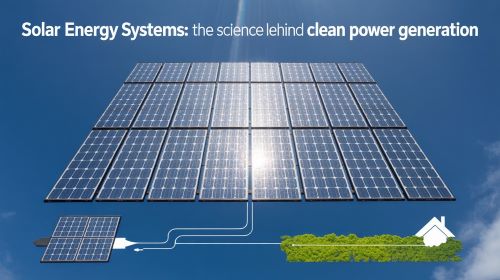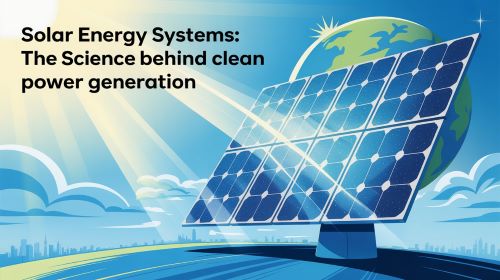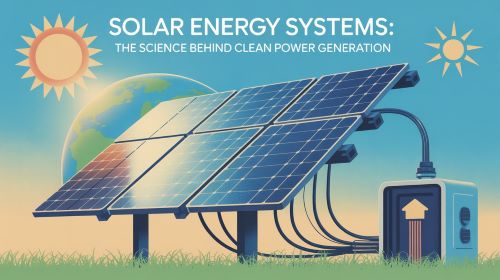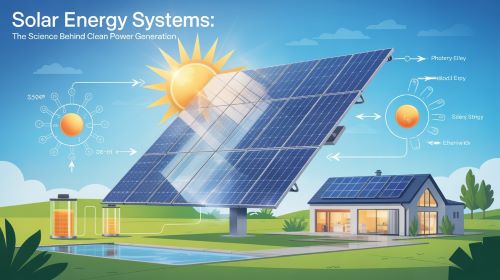Two Fundamental Methods of Electricity Generation , Electromagnetic Induction vs. Photovoltaic Effect
There are fundamentally two ways to generate electricity: , ectromagnetic Induction: Discovered by Michael Faraday in 1821, this method involves generating electricity through the movement of a conductor in a magnetic field. It remains the primary technique used globally, especially in thermal and hydroelectric power plants.

Photovoltaic (PV) Cells: The photovoltaic effect, first observed by Alexandre Edmond Becquerel in 1839, involves converting sunlight directly into electricity using semiconductors like elemental silicon.
What Are Solar Photovoltaic (PV) Cells?
The Building Blocks of Solar Panels
PV cells are semiconductor devices that absorb photons (light particles) and release electrons, creating an electric current. These cells are assembled into solar panels, which are then installed on rooftops, solar farms, or remote off-grid locations.
Breakthroughs by Einstein (photoelectric effect) and Jan Czochralski (single-crystal silicon) helped develop the first efficient solar cells in 1954 at Bell Labs.
How Solar Panels Convert Sunlight Into Power
From Photons to Electricity – A Step-by-Step Process
Semiconductors like silicon are poor conductors at room temperature but become conductive when exposed to light or heat.
Electrons in silicon jump from the valence band to the conduction band when they absorb energy from sunlight.
This transition creates a flow of electric current, which is captured and directed into power systems.
⚡ Keyword Focus: How solar energy works, photovoltaic cells, solar panel working, clean energy science, solar cell electricity generation.
Band Gap and Efficiency Limitations
Why Only Half of Solar Spectrum Is Useful
Only about 49.6% of the solar spectrum can be utilized by silicon-based PV cells:
20.2% of photons have too little energy to generate electricity.
30.2% of photons have too much energy, leading to waste as heat.
This leads to a theoretical efficiency ceiling known as the Shockley-Queisser limit, which is around 33.7% for single-junction silicon cells.
Alternative PV Materials and Their Limitations
Beyond Silicon: GaAs, CdTe, and CIS
Other semiconductors like Gallium Arsenide (GaAs), Cadmium Telluride (CdTe), and Copper Indium Selenide (CIS) can absorb different parts of the solar spectrum but come with challenges:
Scarcity and cost
Environmental toxicity
Manufacturing complexity
Hence, crystalline silicon remains the most widely used material for solar PV panels globally.
The P-N Junction: Heart of Solar Electricity Generation
Creating a Driving Force for Electron Flow
Doping silicon with phosphorus and boron creates a p-n junction, which acts like a built-in electric field.
When sunlight strikes the cell, this junction causes electrons to flow, just like a battery.
Connecting an external load completes the circuit, powering devices or storing electricity in batteries.
Real-World Efficiency of Solar Panels
Lab vs. Commercial Performance
Despite theoretical potential, practical efficiency is lower due to several real-world factors:
Heat loss (7%) as panels operate at 30–40°C above ambient.
Saturation effect (10%) due to imbalanced electron-hole movement.
DC to AC conversion loss in inverters.
Uneven sunlight and shading on different cells.

🔋 Efficiency Breakdown:
Theoretical Efficiency: 33.7%
Best Lab Cells: ~25%
Best Commercial Modules: ~20%
Photosynthesis (For Comparison): 3–6%
Types of Solar PV Technologies
First, Second, and Third Generations
First-Gen: Thick crystalline silicon wafers (~200 µm)
Second-Gen: Thin-film silicon (1–10 µm)
Third-Gen: Tandem and multi-junction cells, including quantum dots and organic PVs
Some third-gen solar cells have exceeded Shockley-Queisser limits, achieving up to 42% theoretical efficiency.
How Solar Panels Get Their Blue Color
Anti-Reflection Coating Technology
Silicon naturally reflects sunlight.
A thin transparent anti-reflective layer (tin oxide or silicon nitride) is added to absorb more sunlight and give solar panels their iconic blue hue.
The Energy-Intensive Production Process
From Silicon Purification to Solar Cell Assembly
Czochralski process purifies silicon to 99.9999% purity.
Ingot slicing into wafers results in 20% material loss.
Ribbon silicon technology aims to reduce waste and costs.
Amorphous silicon cells, while cheaper, require hydrogen doping to improve performance.
India’s Growing Solar Ambition
Imports from China and Domestic Manufacturing Push
India’s 141% rise in PV cell imports from China highlights growing demand for solar energy. However, this is also linked to domestic PV module manufacturing ramping up to meet the nation’s renewable energy goals.
Conclusion: What Solar Energy Can and Cannot Do
Solar’s Role in India’s Renewable Future
✅ What Solar Can Do:
Generate electricity without emissions
Power off-grid areas with standalone PV systems
Reduce dependency on fossil fuels
Enable innovations in solar heating, cooling, and desalination
❌ What Solar Cannot Do (Yet):
Work efficiently during nighttime or cloudy days without storage
Fully replace fossil fuels without energy storage solutions
Overcome cost and efficiency challenges without tech innovation

📈 The Future of Solar Energy in India
With falling costs (from $4–5/watt in 2010 to $1.27/watt in 2023) and better solar PV efficiency, India is poised to lead in solar energy adoption. Continuous research, innovation, and policy support are key to making solar power a mainstream energy source.
🌞 Solar energy in India, PV cells explained, How do solar panels work, solar power for clean energy, future of solar electricity – stay updated with more clean energy news only at khabrainhindustan.com





